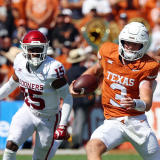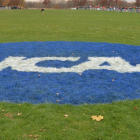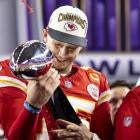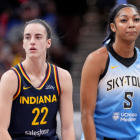Biaggio Ali Walsh, the grandson of Muhammad Ali, isn't just a three-star football player with Division I scholarship offers from schools such as Arizona, Cal, Colorado, Louisville and Vanderbilt. He also recently announced he signed a contract with Wilhelmina Models, a prominent modeling and talent agency.
Assuming Walsh plays college football, you may wonder how this will be allowed by the NCAA, which repeatedly fights to protect what it deems its amateurism model. Walsh's eligibility is safe. He can keep getting paid while an NCAA athlete because he signed with the modeling agency before he enrolled in college.
This particular NCAA bylaw is called "Continuation of Modeling and Other Non-athletically Related Promotional Activities After Enrollment." Yes, there's an NCAA rule for modeling. Who knew? The bylaw requires Walsh to have become involved in modeling for non-athletic reasons; forbids any reference to his name or involvement in college sports while modeling; doesn't allow him to endorse the commercial product; and requires that he get paid at a rate comparable to his skills and experience as a model.
That got us thinking: What other ways can college athletes and/or their families get paid while in school? The NCAA's definition of amateurism is more forgiving than you might think. In the Ed O'Bannon lawsuit, U.S. District Judge Claudia Wilken shot down amateurism as an appropriate defense for the NCAA not to allow players to get paid for their names, images and likeness. Wilken wrote the NCAA changes its definition of amateurism when needed and sometimes "in significant and contradictory ways." Here are just a few ways college athletes already are allowed to get paid:
1. Cost of attendance. The NCAA and universities spin this as additional scholarship money, not a payment stipend. And while semantically that's true, just a decade ago, the NCAA argued in court that cost-of-attendance stipends were a form of "pay for play" and a threat to amateurism. Cost of attendance is the estimated extra money of the price to attend a particular college, as determined by financial aid offices. By 2015, many schools were providing all or some of their athletes with a couple extra thousand dollars a year through cost of attendance. Some coaches publicly worried that other schools' cost of attendance numbers were inflated for competitive reasons and the money would impact recruiting. One year into cost of attendance, there are virtually no stories about players choosing schools due to the extra stipend.
2. Pell Grants. The federal government provides financial aid to students who show a need for money to attend college. The maximum Pell Grant award in 2016-17 will be $5,815 per student. Since lots of college football and basketball players come from low-income homes, many of them receive some Pell Grant money. For instance, the University of Alabama had 131 athletes receive $566,495 in federal aid during 2012-13 (average of $4,324 per athlete). Slightly more than half of those Alabama athletes played football. Under NCAA rules, an athlete who receives a Pell Grant may also receive cost of attendance or the value of a full scholarship plus the Pell Grant, whichever is greater.
3. Pro money in a different sport. In the NCAA's confusing world of amateurism, you can be deemed an amateur in one sport while clearly a professional in another. A pro athlete paid in one sport can simultaneously play college athletics in a different sport and receive a scholarship. It doesn't happen much, but the sport most frequently impacted is a college football player who also participates in minor league baseball. In 2010, Kyle Parker was Clemson's quarterback after he got a $1.4 million signing bonus from the Colorado Rockies. Russell Wilson had a $200,000 signing bonus with the Rockies, some of which he had to return to the club when he left to play quarterback at Wisconsin. Roscoe Crosby had a $1.75 million signing bonus from the Kansas City Royals while a Clemson wide receiver in the early 2000s.
4. Bowl gifts/postseason awards. If a booster gives a player a gift, that's an NCAA no-no. If a bowl game gives a player a gift, this is called a postseason award. A football player can get gifts valued up to $550 from a bowl and up to $400 by his school. There are even bowl gift suites and Visa gift cards for players. In all sports, the NCAA allows schools to give awards to underclassmen (maximum value $225 each) and seniors ($425) for annual participation. There are awards for winning a national championship ($415 maximum per player) or winning a conference regular season/postseason championship ($325). If you win a national award such as the Heisman Trophy, that award is worth up to $325. If you're the MVP of a bowl game or all-star contest, you can get up to $350 in an award. And if you make special contributions to your team's season -- examples cited by the NCAA rulebook are best scholar-athlete, most improved player, most minutes played and most valuable player -- your max award value is $175.
5. Free injury insurance. An NCAA athlete can borrow against his or her future earnings from a lender for loss-of-value insurance in case of a serious injury. In recent years, as the NCAA lessened some restrictions, some schools have paid $50,000 to $60,000 for a very small number of elite football players to get this insurance premium for free. Jameis Winston and Marcus Mariota are among the players who got their premium paid for by their school. Some coaches complained this is a recruiting advantage by offering the possibility of a premium during the recruiting process.

6. Prize money based on performance. In tennis, a player can receive up to $10,000 per year in prize money before or during college. The prize money can only come from the sponsor of an event in which the player participates. Once the $10,000 is reached, NCAA rules state the player can still get additional money if it doesn't exceed his or her necessary expenses for participating in the event. In sports other than tennis, an athlete can get prize money from a sponsor based on his or her finish as long as the amount doesn't exceed the cost to participate.
7. Money for training, international competition. An athlete may get expenses paid for by the United States Olympic Committee to cover development training, coaching, facility usage, equipment, apparel, supplies, comprehensive health insurance, travel, and room and board.
Expenses for Olympic tours and exhibitions are allowed if the college athlete doesn't miss class time or conflict with university competition. Athletes can receive apparel, clothes, footwear and other commemorative items for participating in the Olympics or another international event through a national governing body. A company or local community members may provide expenses and other non-monetary benefits to an athlete's family to attend national team competitions.
8. Student assistance fund. The NCAA provides money to each school to assist athletes who have special financial needs. Some of this can go for needs such as clothing. Those suits you see players wearing before games? They're sometimes paid for from this fund. In addition, the NCAA recently began allowing schools to pay travel expenses for players' families to attend the men's and women's basketball Final Four and the College Football Playoff. The $3,000-$4,000 is meant to cover transportation, hotel and meals for two family members per athlete.
9. Outside employment. The NCAA allows players to have paying jobs. They may rarely have the time to do so, but it is permitted if the work is performed at an amount comparable to the going rate in that area for similar services. The payment isn't supposed to be due to athletic ability or publicity for the employer due to the athlete's presence. An athlete can be employed by his or university, another school, or a private organization to work in a camp or clinic as a counselor.
10. Self-employment. This NCAA rule still says an athlete may establish a business only if his or her name, photo, appearance or athletic reputation are not used to promote the business. But the NCAA now tackles this issue on a case-by-case basis and has said it will grant appropriate waivers if athletes have similar opportunities as other students for entrepreneurial aspirations. Most famously, Minnesota wrestler Joel Bauman tested the NCAA in 2013 by promoting that he was an NCAA wrestler on a music video he produced. Bauman declined to remove his name from any songs and eliminate any promotion of his status as an NCAA athlete. He got declared ineligible, a firestorm erupted, and he brilliantly turned the publicity into a marketing job.
"I knew what I was doing the whole time," Bauman said in "Indentured: The Story of the Rebellion Against the NCAA," a recent book about the college sports industry. "The NCAA is pretty predictable."
















